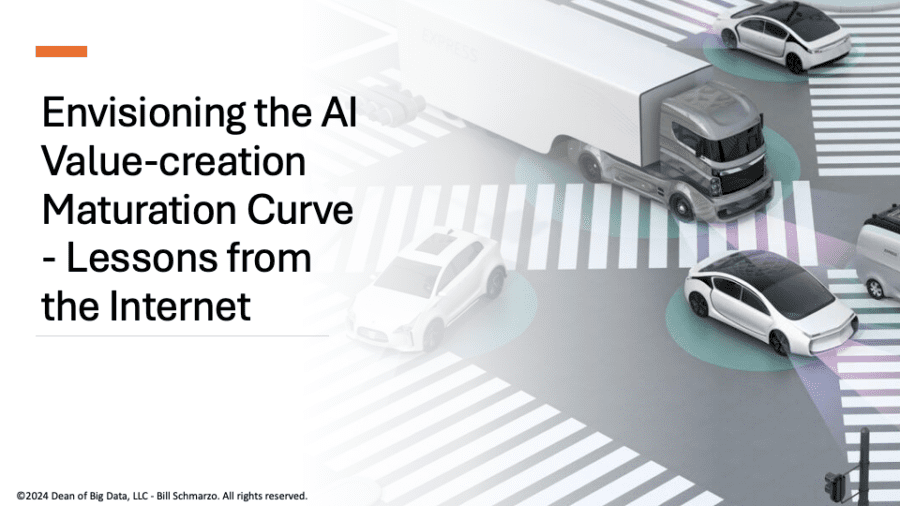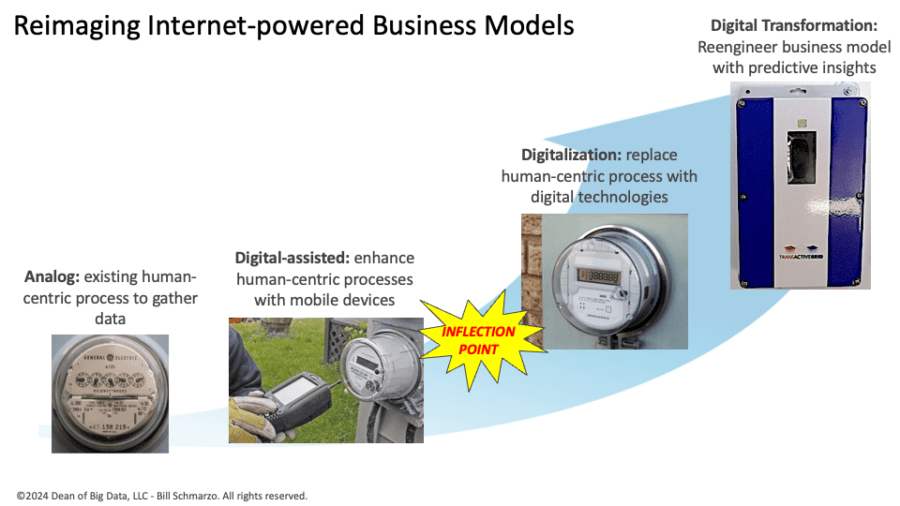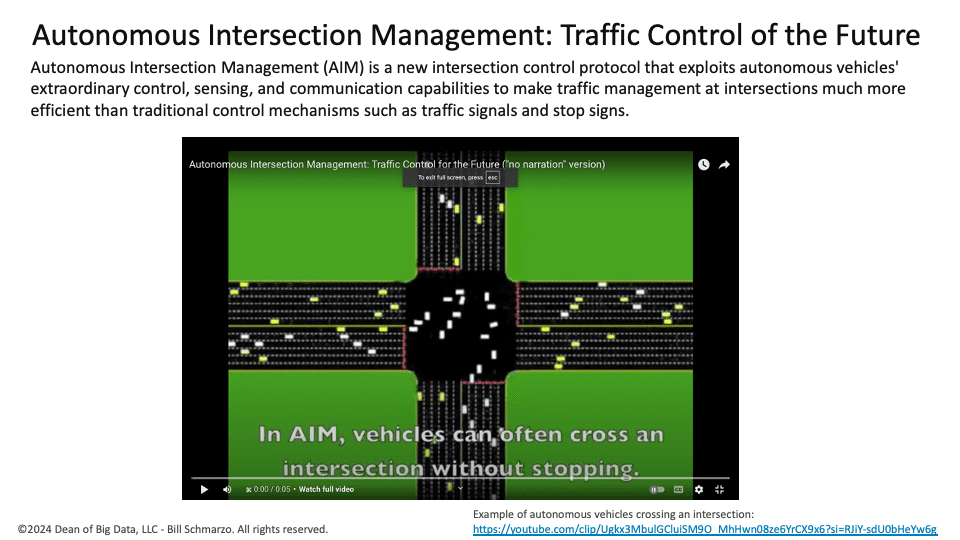
2025 will be the year when Artificial Intelligence (AI) must prove itself beyond driving mundane, easily replicated productivity improvements. To be successful, AI must fuel organizations’ imagination and creativity in creating new sources of customer, product, service, operational, environmental, and societal value.
I struggle to visualize how Artificial Intelligence (AI) will change the world. Yes, I know it is the most significant development since electricity, the printing press, and Cap’n Crunch, but I’ll still have difficulty seeing how AI “changes everything.” So, I sought to compare AI’s potential economic and societal trajectory to what we learned from the Internet’s economic and societal journey.
The Internet’s transformative power was its ability to eliminate time and distance barriers, enabling real-time communication, providing global market access, empowering process reengineering, and spurring new business models and industries.
The Internet fundamentally broke down the physical barriers of time and distance, transforming how we communicated, worked, and conducted business. Because it addressed these limitations, the Internet’s economic and societal impact was easier to visualize and exploit.
However, AI’s economic and societal potential is based on dramatic human cognitive improvements that are harder to envision than the physical impact of the Internet.
AI’s transformative power lies in its ability to amplify human cognitive capabilities and drive intelligence-driven ingenuity and innovation that can personalize experiences and treatments, create autonomous operational processes, fuel new intelligence-driven business models, and accelerate industries’ value creation initiatives.
This blog will draw parallels between the Internet’s value-creation evolution and AI’s current trajectory. We’ll explore how the lessons learned from the Internet digitalization revolution can help us harness AI’s cognitive transformative potential. We’ll delve into the cultural shifts required to unlock AI’s full benefits and examine real-world scenarios in which AI reshapes industries and society, creating new opportunities for growth, efficiency, and innovation.
The Internet Maturation Journey
When the Internet first emerged, many organizations saw it as a tool to optimize existing processes. Email replaced traditional mail, and websites became digital brochures. However, as the Internet matured, companies realized that it was not just about digitally replicating analog processes but about reengineering their business models, reaching out to new customers and markets, and creating entirely new business models and industries, such as:
- Social media transformed personal and professional networking, allowing billions to connect, share, and build online communities.
- E-commerce redefined retail, empowering customers to shop worldwide with a click.
- Telemedicine bridged gaps in healthcare access, enabling remote consultations and care.
- Streaming services revolutionized entertainment, providing viewers with an on-demand content library.
- Cloud computing reshaped IT infrastructure, providing scalable, on-demand resources that power everything from startups to large enterprises.
- The Internet of Things (IoT) connected everyday devices to enable real-time data exchange and automation, leading to more efficient industrial processes.
- Online Education democratized learning by offering courses from various disciplines to a global audience, often for free or at a low cost.
- Digital Payments facilitated instant online financial transactions, streamlining e-commerce and peer-to-peer payments.
The Internet sparked a wave of economic transformation, creating new sources of value creation across every industry. However, organizations needed time and experience to understand, explore, and harness the Internet’s transformative potential (see Table 1).
| Stages | Description | Real-World Examples |
| Stage 1: Productivity Driven | Organizations initially implemented internet capabilities to enhance existing processes and communication but without changing their core operations. | Early email adoption and intranet platforms. For instance, companies used email to replace internal memos and mail, improving communication speed but keeping the underlying processes the same. |
| Stage 2: Process Optimization | Leveraging the internet’s speed and reach, businesses optimized existing processes, improving efficiency and reducing costs. | Supply chain optimization, where internet connectivity enabled real-time updates across global operations, enhancing inventory management and production processes. |
| Stage 3: Process Re-engineering | Companies began to rethink their entire operational approach, using the internet to fundamentally change how they deliver products and services. | Netflix transitioning from DVD rentals to streaming content, redesigning its business model around the internet’s ability to instantly deliver entertainment to homes worldwide. |
| Stage 4: Market Expansion | The internet enabled businesses to enter new markets and reach new customer segments. This phase marked the rise of e-commerce to broaden market access and drive global sales. | Amazon evolved from an online bookstore into a vast global marketplace, leveraging the internet to serve customers worldwide with an expansive range of products. Airbnb used the internet to disrupt the hospitality industry, allowing homeowners to rent out properties, creating new market access for both hosts and travelers. |
| Stage 5: New Business Models | Completely new business models emerged that transformed traditional markets and gave rise to digital-only businesses that exploited global connectivity, Big Data, and user-generated content. | eBay pioneered online auctions, allowing individuals to buy and sell goods directly. Facebook introduced social networking at a global scale, building an advertising-driven model around user-generated content. Uber and Lyft disrupted the transportation industry with ride-sharing, leveraging mobile internet to connect drivers and passengers. |
| Stage 6: Ecosystem Maturation | Organizations began building ecosystems and platforms that allowed third parties to create new business opportunities. This phase fostered communities of developers, entrepreneurs, and partners, leading to a self-sustaining ecosystem that amplified the value of the core platform. | Apple’s iOS and Google’s Android platforms allowed developers to create apps that enrich the mobile experience, generating value for users, developers, and platform owners alike. Amazon Web Services (AWS) provides cloud infrastructure for startups and enterprises, extending Amazon’s reach into multiple industries. Shopify established a platform for e-commerce businesses, enabling entrepreneurs to build online stores while expanding Shopify’s ecosystem. |
Table 1: Internet Value-creation Maturation Stages
The key to the Internet’s success was shifting from a productivity-focused mindset (focusing on speed and reducing costs) to an effectiveness-driven mindset (focusing on doing better, being more impactful, and fostering creativity). This transition enabled organizations to move beyond merely digitally replicating existing processes to reengineering innovative solutions that provide more profound value and transformative outcomes (Figure 1).

Figure 1: Reimagining Internet-powered Business Models
The Potential AI Maturation Journey
AI is poised to drive a new revolution that amplifies human cognitive capabilities and creativity. By reengineering workflows, enabling real-time decisions, and enabling autonomous products and services that require minimum human intervention, AI empowers organizations to be more efficient, creative, and strategic while preserving the essential human touch.
For example, intelligent, autonomous vehicles can dramatically impact transportation and logistics by replacing human cognitive inefficiencies (Figure 2).

Figure 2: Example of autonomous vehicles crossing an intersection
If AI adoption follows a similar trajectory as Internet adoption, we might see the following AI maturation journey (see Table 2).
| Stage | Description | Real-World AI Examples |
| Stage 1: Productivity Driven | AI is used to enhance existing processes by automating routine tasks, making operations faster and more efficient. At this stage, AI tools are implemented to perform specific tasks without altering the underlying processes. | ChatGPT for automating customer service responses, Robotic Process Automation (RPA) in finance to handle data entry, and AI-driven email sorting to prioritize inbox management. In healthcare, AI-assisted medical transcription speeds up documentation for practitioners. |
| Stage 2: Process Optimization | AI is leveraged to optimize key business operations, assisting in decision-making, reducing errors, and optimizing resource allocation. AI systems now begin to actively assist human roles without fully replacing them. | Predictive maintenance in manufacturing, where AI analyzes equipment data to forecast failures. In retail, AI-driven inventory management optimizes stock levels based on demand predictions. In finance, fraud detection algorithms identify unusual patterns to reduce risks. |
| Stage 3: Process Re-engineering | Organizations redesign their operations, fully integrating AI into decision-making and operational processes, which leads to new approaches in core business functions. | Autonomous vehicles re-engineer logistics and delivery transportation. In healthcare, AI-driven diagnostics assist with analyzing patient data for early detection of diseases. Algorithmic trading in finance restructures investment strategies through high-frequency, data-driven decision-making. |
| Stage 4: Market Expansion | AI enables businesses to reach new markets and offer more personalized, scalable solutions. Through advanced machine learning, organizations transcend previous operational limits and deliver customized offerings to broader audiences. | Personalized retail recommendations on platforms like Amazon or Netflix create tailored shopping or viewing experiences. AI in fintech enables tailored investment advice and financial services for underserved populations. Language translation AI breaks language barriers, enabling businesses to connect with global markets. |
| Stage 5: New Business Models | AI drives new business models, fundamentally redefining how value is created and delivered. These models rely on intelligence as a core operational component and can adapt in real time. | Autonomous drone delivery from companies like Zipline and Amazon, AI-powered content creation platforms for image and text generation. New customer service models like virtual personal assistants redefine customer interaction and engagement. |
| Stage 6: Ecosystem Maturation | AI expands towards building AI-accelerator ecosystems that emphasize responsible, ethical AI use and collaborative governance frameworks. These ecosystems include multi-stakeholder platforms focusing on transparency, inclusivity, and data governance. | AI governance frameworks developed by organizations like Google and Microsoft ensure responsible deployment. AI ethics councils and initiatives like the Partnership on AI promote ethical standards. AI-powered data marketplaces allow businesses to access and share data responsibly, fostering innovation while upholding data privacy standards. |
Table 2: AI Value-creation Maturation Stages
AI Maturation Projection Summary
AI is a powerful force multiplier for human cognitive expansion. It can fundamentally reimagine established processes and reshape entire industries in innovative and unforeseen ways. AI sparks creative exploration, provides valuable insights, and encourages innovation and new ideas to flourish. Most notably, it offers a previously unattainable level of personalization, tailoring experiences to meet users’ unique preferences and needs in real time.
The key to fully harnessing AI’s vast cognitive potential lies in transitioning from a traditional productivity-focused mindset to an innovation-driven mindset. This more transformative approach involves reimagining, reengineering, and fundamentally transforming organizational value creation. Ultimately, embracing this shift will pave the way for enhanced efficiency and unleashing individual creativity and innovation (Figure 3).

Figure 3: Stages of AI (Cognitive Amplification) Maturation

Well done! You had me at Cap’n Crunch!
I may (with permission, of course) use this in my course called Project Value Strategies at Boston University’s Metropolitan College.